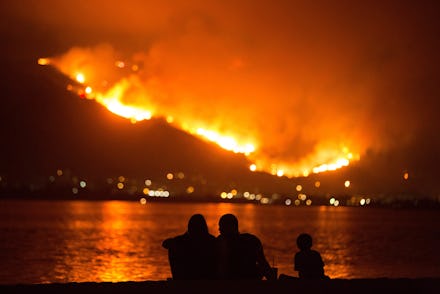How wildfires, hurricanes and other disasters worsen the racial wealth gap in America

Natural disasters are devastating Americans in unbelievable numbers. Weather events such as floods, droughts and hurricanes cost the U.S. more than $300 billion in 2017 alone. Meanwhile, at least 1,400 people in Puerto Rico died because of Hurricane Maria — though estimates vary depending on the source — and Californian wildfires continue to kill residents and threaten thousands of homes.
There’s no doubt these disasters have a life-altering impact on victims. But Americans of color have a much harder time financially recovering from them, according to a recent study — a fact that widens the already existing problem of wealth inequality.
Researchers from the University of Pittsburgh and Rice University followed 3,500 families in the United States between 1999 and 2013, examining data on “local natural disaster damages, Federal Emergency Management Agency aid aid and demographics.”
The study found that people living in some of the worst-hit counties had different financial outcomes depending on their race. In counties that incurred more than $10 billion in damages, whites saw average wealth increases of $126,000. Meanwhile, black, Asian or Latinx communities in the worst-hit areas saw overall decreases in wealth. Among these worst-hit counties — again, areas that suffered more than $10 billion in damages — people living in traditionally black neighborhoods lost $27,000 in wealth on average, while Latinx communities lost $29,000 and Asian communities $10,000.
“Put another way, whites accumulate more wealth after natural disasters while residents of color accumulate less,” Jim Elliott, one of the study’s authors and a professor of sociology at Rice University, said in a press release. “What this means is wealth inequality is increasing in counties that are hit by more disasters.”
It’s a depressing discovery, but it’s not the only way natural disasters widen the wealth gap between white people and people of color. The study also found that counties receiving the highest amounts of FEMA aid were more likely to suffer a greater wealth gap between races beyond the impact of the natural disaster itself.
Here’s what that means: Black communities living in counties that received the most FEMA aid — $900 million from 1999 to 2013 — actually accumulated $82,000 less wealth on average than did black people living in counties that received only $1,000 in FEMA aid. The story is similar for Latinx and Asian individuals. It does sound a little counterintuitive — one would expect people living in areas receiving the most FEMA aid to also accumulate the most wealth from disaster recovery. However, that’s not the case.
The truth is, researchers don’t know why this phenomenon exists. However, “based on previous work on disasters such as hurricanes Katrina and Harvey, we know FEMA aid is not equitably distributed across communities,” Junia Howell, one of the study’s authors and an assistant professor of sociology at the University of Pittsburg, said in a press release. This means, for instance, that some residents living in a community with high amounts of FEMA aid will have a better chance at rebuilding heir homes and recovering lost property value. Sadly, others will lose out.
“When certain areas receive more redevelopment aid and those neighborhoods also are primarily white, racial inequality is going to be amplified,” Howell said.
The conclusion is clear: Natural disasters only make income inequality worse for people of color. But knowing this also means we have an opportunity to counter this sad reality in future disaster recovery missions.
“The good news is that if we develop more equitable approaches to disaster recovery, we can not only better tackle that problem but also help build a more just and resilient society,” Howell and Elliott said.